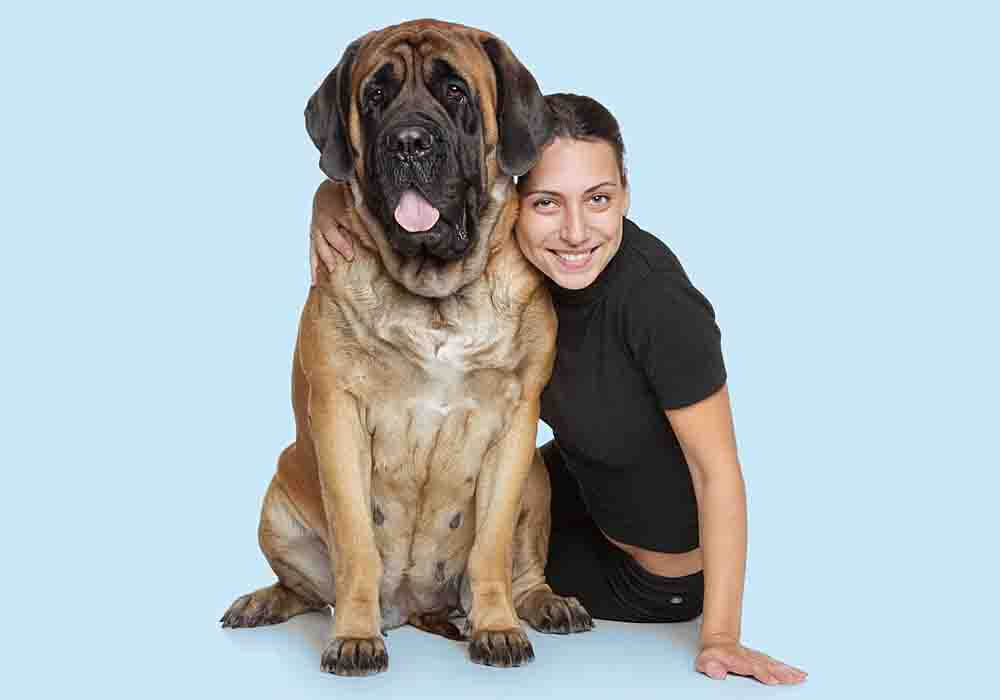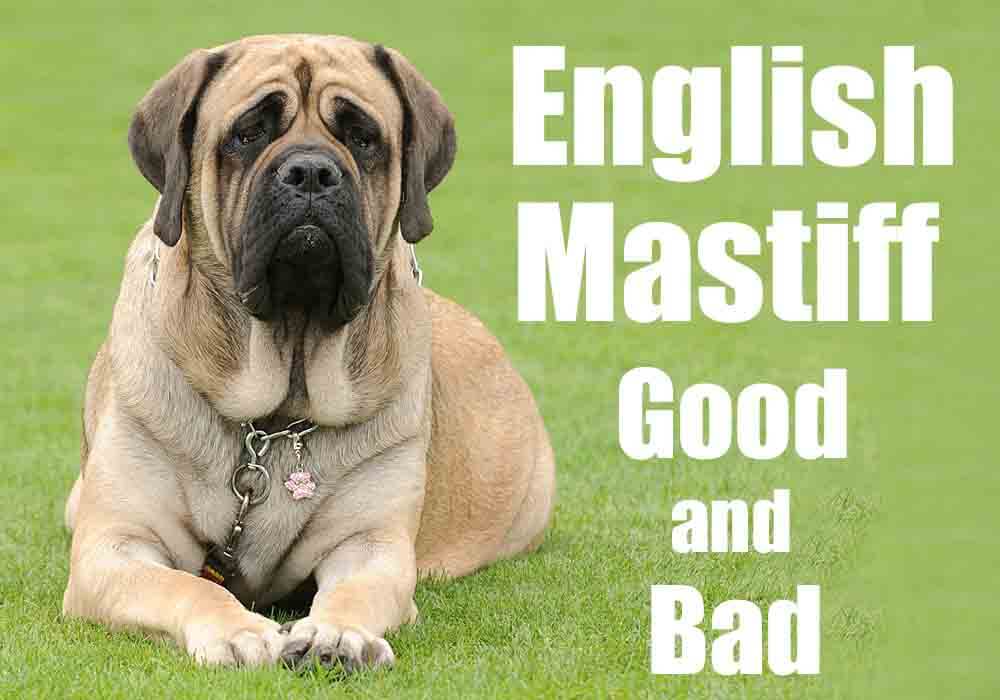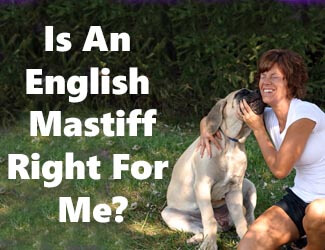English Mastiff Dog Temperament
and Personality Traits
What's This Breed Really Like?
by Ken Alden
Looking for your next pet and considering the English Mastiff? Well, once you get one, you may never have to look again. Mastiff lovers are generally as loyal to the breed as the breed is to them, and for a good reason.
English Mastiff Dog Temperament And Personality Traits Are...
- They are generally very friendly and docile
- They appreciate the company of humans, other dogs and cats too!
- They’re prone to separation anxiety
- They’re more of a “watch” dog than a “guard” dog
- Because of their patience they’re loved by kids and make a great family dog
If you're considering a Mastiff as your next or first dog, there are some things you should know about them first. In the following article, we'll address the main personality traits of the breed, including how good they are with children, the elderly, and other pets. We'll also discuss their temperament as they go from puppy to adult. Read More Below...
Pro-tip: Ever try lifting an English Mastiff? Their weight can hurt not only your back but their joints when they hop down from cars, sofas or even your bed. To protect your back and theirs check out the best Mastiff ramps on Amazon.com now.

English Mastiff: An Introduction
The English Mastiff, (sometimes called the Old English Mastiff or simply just "Mastiff") is a breed that was truly established in the 1880s, though it was used as a war dog for hundreds of years before that. The reason why is obvious as soon as you see a Mastiff; they have large heads, wide shoulders with muscular chests, and are truly massive.
Recognized as the largest dog breed in the world, a Mastiff named Zorba holds the world record as the heaviest dog ever recorded. Though he passed away in 1992, Zorba weighed a whopping 343 pounds (155 kg).
While these dogs are large, and they used to be used in warfare,
their current lineage is much more benevolent. Mastiffs make great family dogs,
as long as you have the room for them. english mastiff dog temperament and personality traits
English Mastiff Puppy Temperament
and Personality Traits
These dogs are one of the breeds that tend to be quite different as puppies than they are as adults. As puppies, Mastiffs are playful, goofy, and love to run around. Like most puppies, the Mastiff loves to play with other dogs, chew things, and roll in the grass.
However, there are some important things to note that are specific to this breed.
They Aren't Fully Grown Until Three Years Old
Mastiffs don't fully mature mentally or physically until they are three years old. You'll have to stick with your training regimen for a lot longer than you may think to get your commands to stick.
Also, you need to be careful with how much exercise you let your puppy do. Giant breeds are much more at risk of long-term damage from being over-exercised as a young dog since their joints and bones continue growing for so long. The dogs are also more prone to joint conditions such as hip dysplasia as adults, and that can be exasperated by too much activity as a puppy.
They Need to Be Socialized and Quick!
While studies have shown that English Mastiffs have low aggression towards their owners, these studies have also revealed that Mastiffs have medium aggression towards strangers. To counteract the chance that your Mastiff could hurt a human, you need to socialize her as a puppy.
As soon as she comes home, try introducing her to ten new people
and three new dogs, every day. Do this for a month, and you will have a
wonderfully socialized puppy.
Training Must Be Consistent
Many people describe Mastiffs as having low intelligence, but the fact is, they are more stubborn than stupid. If a dog of this breed doesn't want to do something, they'll simply sit down. When your dog is a puppy, you'll be able to lift her and move her where you want her to go, but try this with a fully grown Mastiff, and you'll fail miserably. english mastiff dog temperament and personality traits
Consistent training as a puppy is the key to controlling your dog when she's an adult. As with socialization, it's important to introduce the behaviors you want to see in your mature dog as soon as she comes home. Because as she gains size, you'll lose control
They Are Prone to Separation Anxiety
As with many breeds that are extremely attached to their humans, English Mastiffs can easily develop separation anxiety. The worst thing to do for a dog with separation anxiety is to be with him all of the time. As a puppy, you need to spend many hours away from your dog, allowing them to become comfortable with being alone.
While this breed will always prefer to be with his people, you can help ease the anxiety by teaching him from a young age that you will always come back. You can do this by leaving the room for five minutes at a time, many times throughout the day. Increase each trip away by five minutes, until you can spend an hour away from your dog.
Every time that you return to the room don't make a big fuss about your puppy. Walk around the room, carrying on with your activities for another five minutes. At this point, you can calmly greet your pup and give her treats. Then, go back to your tasks. Don't make a big deal when you leave the room either, as this will help the coming and going of humans to feel much more natural (and less terrifying) to your new best friend.
Pro-tip: English Mastiff anxiety, aggression, destructive chewing, jumping up, fearfulness, and other behaviors can be controlled with the right training program.
Here’s a great course that
addresses these issues along with many other dog training basics: Check it out now!
English Mastiff Adult Temperament
and Personality Traits
English Mastiffs are, generally, very loving dogs. They are fond of a long cuddle session and will usually sit near your side–just in case you happen to have time for a pat. Belly scratches and ear rubs will go a long way in showing your Mastiff how much you love them. They respond very well to human affection, and using this tool in your training will help reinforce their obedience.
These big dogs may try to get on your furniture, as they love to be cozy. Make sure that you either train your dog not to do this, or prepare mentally for the impending damage to your sofa. As these canines are solid at 200+ lbs (90+ kg), the repeated climbing on and off your furniture will no doubt wear out the springs in your couch, and their solid nails can easily rip holes in the upholstery.
English Mastiffs are happiest hanging around their family members all day long. They would love to come with you to work if you happen to have a dog-friendly workplace. These dogs are a great option for a “shop dog” or an office dog, as they are happy to lay around for most of the day, simply enjoying the human companionship.
Your Mastiff will also love to spend afternoons in the yard, watching the children play. They are very patient and will enjoy being included in the kids’ games, even if they don’t appear overly enthused by little hands prodding at them. They won’t, however, enjoy being left alone in the yard for extended periods of time.
Mastiffs thrive on human attention, but as we’ve learned, they suffer from separation anxiety when they are alone. A Mastiff is not a good option for an outdoor watchdog, as they will probably be too sad to do any real defending. This breed is also not a good match for people who spend extended periods of time away from their home; another reason why Mastiffs are great family dogs, because odds are one person will often be home to cuddle with them. eenglish mastiff dog temperament and personality
nglish mastiff dog temperament and personali
Female English Mastiff Temperament: Adult
As your Mastiff ages, they will settle down greatly. Adults of this breed tend to be very calm, quiet, and loving. Females usually have a little more spunk in them, as they are slightly smaller and more agile. A female will also be more protective of their young if you decide to breed her.
Both genders are known for being great companions, though, and whether you get a boy or a girl, you'll have found a friend for life.
English Mastiff Dog Temperament And Personality Traits
English Mastiff Male Temperament: Adult
Both male and female Mastiffs carry similar traits. They like to hang out with the family, be included, and cuddled. Neither gender enjoys being left alone for long periods of time.
Males, in particular, have been known to disagree with other male dogs in the household. It is often recommended to get the opposite gender of Mastiff if you already have a dog in the home, though there are many circumstances where two male dogs have been completely fine with each other.
Personality Traits of an English Mastiff: The Good and Bad
As you've read so far, there are many amazing things that draw people to the Mastiff breed. A lot of people who have had one Mastiff get another because they are so agreeable. However, it's not all sunshine and rainbows with these dogs, and they do have some negative features. Let's look at some of the good and bad aspects of this breed.
The Positive
They're very loving
Good with children
Enjoys cool weather
Will protect family
Not a flight risk
Needs medium level of exercise
They're very loyal
The Negative
They do slobber a lot
Large and clumsy
Overheats quickly in summer
Will snore and fart
Prone to health issues
They don't like being alone
Destructive when anxious
English Mastiff Dog Temperament
and Personality Traits FAQs
Still not sure if this is the breed for you? Let's answer some of the most common questions asked about the Old English Mastiff.
Do English Mastiffs Make Good Pets or Family Dogs?
Yes, English Mastiffs make excellent family pets. These canines are extremely loyal, and they love nothing more than to lay on the lawn with you and your family. If you have a big house where usually at least one family member is home, then the Mastiff is an excellent choice for you.
English Mastiff Dog Temperament And Personality Traits
Are English Mastiffs Considered Aggressive Breeds?
While some countries have banned other varieties of mastiffs like Cane Corsos and Dogo Argentinos because of their expected aggression, almost all countries allow English Mastiffs. Of the Mastiff types, Old English Mastiffs are among the friendliest, though they will protect their family if absolutely necessary.
Are English Mastiffs Good Watch Dogs?
Yes, but they aren’t the greatest guard dogs as they are unlikely to run up and attack an intruder. They may bark– and loudly– but they aren't likely to get physical with a human, especially if they've met them before.
A Mastiff is better as an alarm system in your home than a dog that will protect your property. Though we can’t think of too many burglars that will try anything once they see your 200lb. pal and hear his 200lb. bark!
Pro-tip: English Mastiff's (and their owners) love dog crates…and for good reasons. Crates keep dogs from mischief while you're away, are perfect for house training, for traveling by car, and provide the dog a place to de-stress. Check out the best Mastiff crates on Amazon.com now.
Are English Mastiffs Protective of Their Owners?
Yes, English Mastiffs are extremely attached to their people and would gladly stand in harm's way for them. These canines have a very intimidating bark and aren't afraid to use it if they suspect something unsavory is about to happen.
Do English Mastiffs Make Good Service Dogs?
Yes! Because of their mild manner and love of people, English Mastiffs make great service dogs. While they may be better suited to act as an anxiety dog than a seeing-eye dog, they still have a great place in the world of service.
How Popular Are English Mastiffs?
In the United
States of America in 2019, Mastiffs ranked as
the 32nd most popular dog breed. This is quite impressive considering that
between 1906 and 1918, only 24 dogs of the breed were registered in the US.
Are English Mastiffs Good With Cats and Other Dogs?
It depends. If you get your Mastiff as a puppy, you have a much greater chance of ensuring that she is good with other animals. While they inherently have a low prey drive, the one time a Mastiff lashes out at an animal could be devastating.
It's unlikely that a Mastiff raised with animals would ever be violent towards them, as they have a lot of patience and generally enjoy the companionship of other living things. As mentioned above, some males may be reactive to other males in their household, but this isn't always the case.
Are English Mastiffs Good With Babies and Toddlers?
Yes, English Mastiffs tend to love babies and toddlers. However, you should watch a Mastiff around young kids because the dogs are so large, they could easily knock them over. A young dog especially should be overseen with children, as they are very exuberant and don't know their own size or strength yet.
Needless to say they make great family dogs!
Are English Mastiffs Messy Dogs?
An English Mastiff puppy could make a bigger mess than your children ever do. Especially if under-stimulated. Puppies of all sorts need exercise and mental training to drain their energy, but the damage that a Mastiff can deliver is much greater. An anxious or bored Mastiff can chew, shake, dig, and claw his way into a big mess if you leave him alone for too long. english mastiff dog temperament and personality traits
Do English Mastiffs Drool a Lot?
Yes, these dogs are major droolers and slobberers. While other dogs drool only when there is food in front of them, Mastiffs drool all the time. These dogs will not only drool, but as soon as the drool is nice and long, they will shake their heads and fling the drool all over your living room.
Do English Mastiffs Snore?

Sometimes, not all of these canines snore, but it is a common feature of the breed. Most of them are quite flatulent, though, and you should not get this dog if you are severely put off by bodily functions.
Do English Mastiffs Shed a Lot?
Mastiffs are a medium shedder. They have short hair that falls out in small amounts every day, but a week without a brush and you'll notice hair all over your house. To counteract the shedding of your Mastiff, you should brush her twice weekly, and outdoors if possible.
Are English Mastiffs Hypoallergenic?
No, this breed is definitely not Hypoallergenic. Their short hair and medium shedding amount cause their fur to spread all over the place, which would be a terrible match for someone with allergies.
How Much Exercise Do English Mastiffs Need?
While these dogs don't need nearly as much exercise as a Border Collie, they need more movement than people usually think. Three half-hour walks a day would be great exercise for your Mastiff, whether she pretends she's too tired or not.
How Long Do English Mastiffs Live?
With the proper exercise and diet, English Mastiffs can live for up to 10 or 11 years, which is quite long for a giant breed.
Are English Mastiffs High Maintenance?
This depends on what you consider high maintenance. This is how
Mastiffs rate on a scale of
maintenance factors:
Factor
Home space needed
Okay with being alone
Good in hot weather
Good in cool weather
Grooming needs
Amount of shedding
Ease of grooming
Exercise needed
Food needs
Energy level
Mess level
Rating
4/5
1/5
1/5
4/5
3/5
3/5
4/5
2/5
3/5
2/5
4/5
English Mastiff Dog Temperament And Personality Traits...Final Thoughts
As the largest dog breed in the world, Mastiffs have a lot to live up to. They fill their giant paws well, with lots of love and loyalty for their families. This breed is an excellent choice for a family with a large yard, medium exercise level, and the patience to train the breed correctly.
Back To Top Of This English Mastiff Dog Temperament And Personality Traits page

About the Author...
Ken Alden, a dedicated Mastiff owner for over eight years, is acclaimed for his expertise in care, grooming, and training. Read more About Me and my dog Shadow.
- Mastiff Guide Home ›
- English Mastiffs ›
- English Mastiff Dog Temperament And Personality Traits






